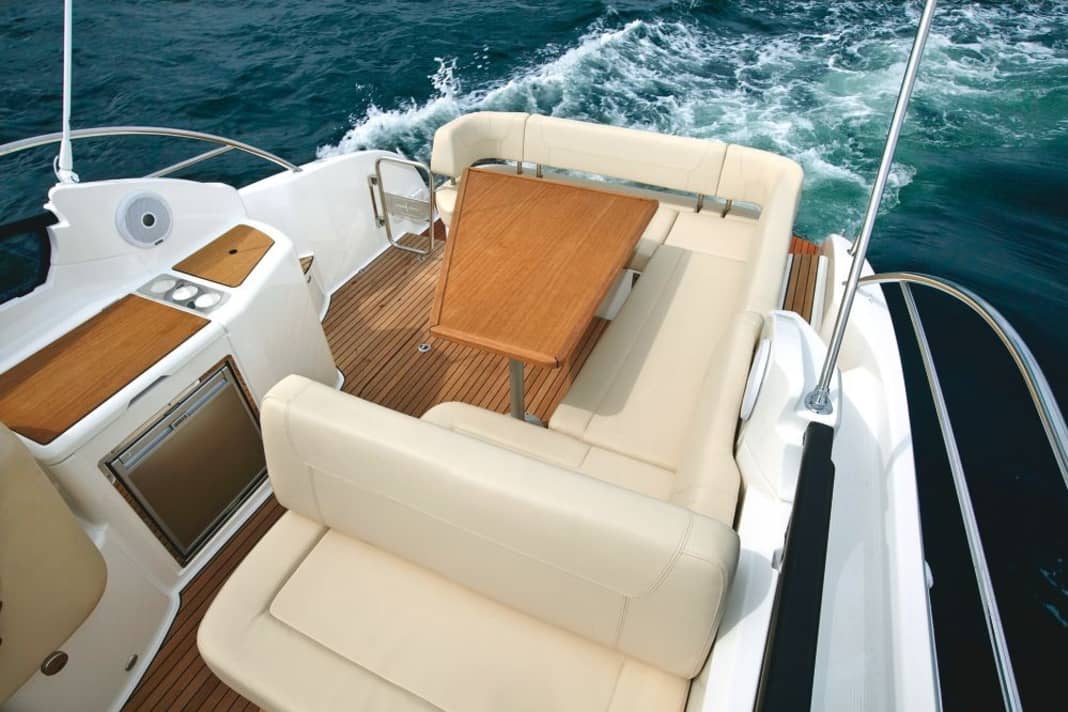
Ever since the Bavaria 360 Coupé was presented in issue 03/2015, we have known that a new wind is blowing at Bavaria, at least in terms of appearance. Even the smaller models have not been "spared", such as Bavaria's entry-level boat, the Bavaria Sport 29, which has now been rebranded as the Sport 300. It is available with a plastic equipment carrier, then called Sport 300 Open and without a bracket simply Sport 300 S.
The change is primarily noticeable on deck, where the stern sunbed, which is also the engine compartment lid with storage space, has been completely removed. Instead, the U-shaped seating area has been moved aft to make way for a passenger bench seat at the front.
The furniture finish conveys a high level of quality and gives the viewer the impression of luxury class.
And the rear sunlounger is not completely gone either. It is created by converting the seating area and cockpit table into a sunbed. In addition to changing the design, we have not lost sight of quality
As far as the craftsmanship is concerned, the plastic workmanship on the outside and inside is flawless, and it has even been possible to touch up the one or other plastic cut edge. The furniture finish conveys a high level of quality and gives the viewer the impression of top-class quality. For example, the locker covers in the saloon are finely lacquered and are held in place by steel strands to prevent them from opening too far - if they hold.
For the technical and electrical installations, we say "top" in the visible area and "hm" where you don't look otherwise
In the underfloor cabin, for example, we discover bundles of cables behind removable ceiling and wall covers that chafe on untreated plastic cut edges, and open copper strands, such as on the connections of the isolating diode in the engine compartment, are future "problem makers" - as are the supply hoses of the toilet in the bathroom. They chafe on sharp cut edges.
The fuel lines to the engines have also been laid better, and nobody can explain to us what a fuse for the shore connection at the very back at the top of the engine compartment is doing - which means a downgrade in terms of technical and electrical installations. There are no weaknesses in the visual area.
The quality and sailing characteristics are okay. On the Baltic Sea, we have to adapt to the water and weather conditions.
We make our first trips plus photos on the Baltic Sea, the actual test measurements later on the Main due to technical problems.
Debit and credit
With two motors and drives, you can almost turn on the spot when one gear is set to "forwards" and the other to "reverse". The straight-ahead running is determined by synchronised motors at the push of a button, and the bow thruster (extra) favours longer reverse journeys.






Mooring and casting off works well. During slow passages, we travel at 6 knots so that the waves generated by the boat do not interfere. A smooth break in the water at around 11 kn signalled that the test boat was beginning to planing. The foresight is only gone for a short time until full planing speed is reached.
A speed of at least 21 knots is necessary to keep the boat planing. Both engines are allowed to turn a maximum of 5000 rpm, we measured a tad less and a maximum of 43 knots was logged in the GPS.
The fact that we "scratched" the upper speed limit nevertheless speaks in favour of suitable propellers in view of the low load condition of the test boat. After analysing our measured values, the test boat glided most economically between 24-29 kn or 3200-3600 rpm.
One tank of fuel is then sufficient for a theoretical range of 169 nm plus 15 % reserve
At slow speed, you can cover around 179 nm and at full throttle around 121 nm before you run out of reserves. This means that the test boat in the 30-foot class does not fulfil our minimum range requirement.
Looking at the dimensions, the Sport 300 S has the same hull as the Sport 28 and Sport 29, so we expect similar reactions in the normal and extreme manoeuvres as in the previously tested boats, where we drove the Sport 28 with a V8 petrol engine and the Sport 29 with two diesel engines. This is the case except for the 180° turns, which we complete at 4200 rpm at a speed of 34 knots, and the slalom test at full throttle.
Turns can be made in one go with fully trimmed drives with an acceptable rocking motion without the hull hooking. With optimally trimmed drives, there are two more violent rocking movements plus the fact that the driver's seat cannot withstand the centrifugal forces (2.0 g) and tears itself loose. As a result, we decided not to do the 180° turn to starboard.
In the slalom test, we can literally "throw" the test boat over the longitudinal axis thanks to the powerful Bravo III Z drive with V8 power - commentary:
Holla, it's fun, no problems and stays safe! Normal cornering is always in the green zone.
We parry waves and rough water on the Baltic Sea with an adapted sailing style, and against wind and waves there is sometimes spray. However, this is normal in view of the more spacious hull. We find the wiper area in front of the driver too small, and from 4000 rpm the sound pressure exceeds the 85 dB/A limit. Apart from the reflections in the windscreen, there is nothing to complain about at the driving position.
Technology, fuel and electricity
We have not seen a boarding aid in the engine compartment either in the boat or in the accessories list. Once down, nothing stands in the way of inspections and servicing. Solenoid valves regulate the fuel flow; cleaning is left to the engine manufacturer. The batteries are permanently mounted and are activated by a relay on the control stand. Fuses can be found either on the control stand or behind the wall cover in the underfloor cabin.
Security
We rate the manual bilge pump and fire extinguishing system in the engine compartment as positive features, but you can get bloody fingers from protruding grub screws between the seat cushions on the backrest brackets. Another drawback: there are no handrails in the rear cockpit.
Living, cockpit and equipment
With unchanged hull dimensions, not much has changed below deck apart from a few centimetres here and there. Bavaria is simply the leader in terms of space and living comfort.
At the front, the seating area with table converts into a lounger, and in the underfloor cabin you lie on the double berth. The headroom is just right except for the entrance to the bathroom. The galley also leaves little to be desired with a cooker, fridge, ample work surface and practically organised storage space.
Those who climb from the stern onto the port side deck must be agile, and those who then use the flagpole as a handhold only do so once ...
Body control is required if you have to avoid the plug-in light on the way forwards. However, this obstacle should be removed and placed in a favourable position. The "royal road" forwards to the anchor and sunbed is and remains the starboard side deck. The fact that the railing protrudes beyond the boat makes an impression, and not just on lock walls. Equipment influences prices, the standard is impressive.
But if you want a bimini or camper top, you have to tick "equipment carrier" - and since the tarpaulin also costs extra, we devalue this.
Our conclusion
The Sport 300 has the familiar hull of the Sport 28 or 29 with a new look. The quality and handling characteristics are right so far, but there are a few weak points behind the scenes. We don't know how the 300 rides with the new V6, but with the old V8 it was a bit stubborn at the limit - but not unsafe with a sensitive "steering and throttle hand".






Data sheet: Bavaria Sport 300
Shipyard: Bavaria GmbH
Type designation: Bavaria Sport 300
CE category: B - Outside coastal waters
Material of hull and deck: Plastic
Length: 9,31 m
Width: 2,99 m
Displacement: 4,70 t
Price: 117.691,00 €

